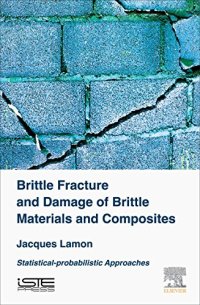
Ebook: Brittle Fracture and Damage of Brittle Materials and Composites. Statistical-probabilistic Approaches
Author: Jacques Lamon
- Tags: Fracture mechanics, Fractures Open, Brittleness, TECHNOLOGY & ENGINEERING, Engineering (General), TECHNOLOGY & ENGINEERING, Reference
- Year: 2016
- Publisher: ISTE Press - Elsevier
- Edition: 1
- Language: English
- pdf
Flaws are the principal source of fracture in many materials, whether brittle or ductile, whether nearly homogeneous or composite. They are introduced during either fabrication or surface preparation or during exposure to aggressive environments (e. g. oxidation, shocks). The critical flaws act as stress concentrators and initiate cracks that propagate instantaneously to failure in the absence of crack arrest phenomena as encountered in brittle materials.
This book explores those brittle materials susceptible to crack arrest and the flaws which initiate crack induced damage. A detailed description of microstructural features covering numerous brittle materials, including ceramics, glass, concrete, metals, polymers and ceramic fibers to help you develop your knowledge of material fracture.
Brittle Failure and Damage for Brittle Materials and Composites outlines the technological progress in this field and the need for reliable systems with high performances to help you advance the development of new structural materials, creating advantages of low density, high resistance to elevated temperatures and aggressive environments, and good mechanical properties.
- The effects of flaw populations on fracture strength
- The main statistical-probabilistic approaches to brittle fracture
- The use of these methods for predictions of failure and effects induced by flaw populations
- The application of these methods to component design
- The methods of estimation of statistical parameters that define flaw strength distributions
- The extension of these approaches to damage and failure of continuous fiber reinforced ceramic matrix composites